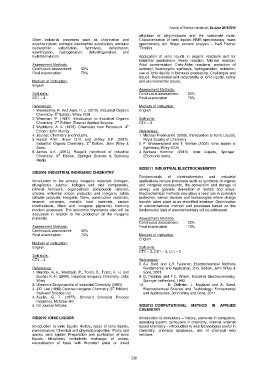Page 245 - handbook 20152016
P. 245
Faculty of Science Handbook, Session 2015/2016
alkylation of alkylimidazole and the carbonate route.
Other industrial processes such as chlorination and Characterisation of ionic liquids: NMR spectroscopy, mass
oxychlorination, aromatic electrophilic substitution, aromatic spectrometry etc. Water content analysis – Karl Fischer
nucleophilic substitution, hydrolysis, dehydration, Titration.
esterification, hydrogenation, dehydrogenation, and
hydroformylation. Application of ionic liquids in organic reactions and for
industrial applications: Henry reaction, Michael reaction,
Assessment Methods: Aldol condensation, Diels-Alder reactions, protection of
Continuous assessment: 30% carbonyl, heterocyclic synthesis, hydrogenation, oxidation;
Final examination: 70% use of ionic liquids in biomass processing. Challenges and
issues: Recoverable and recyclability of ionic liquids, safety
Medium of instruction: and environmental issues.
English
Assessment Methods:
Soft skills: Continuous assessment: 30%
CT1 – 3 Final examination: 70%
References: Medium of instruction:
1. Weissermel, K. And Arpe, H. J. (2010). Industrial Organic English
th
Chemistry. 5 Edition. Wiley-VCH.
2. Wiseman, P. (1987). Introduction to Industrial Organic Soft skills:
nd
Chemistry. 2 Edition. Elsevier Applied Science. CT1 – 3
th
3. Waddams, A. L. (1978). Chemicals from Petroleum. 4
Edition. John Murray. References:
4. Journal: Chemistry and Industry. 1. Michael Freemantle (2009). Introduction to Ionic Liquids,
5. Harold A.W., Bryan G.R. and Jeffery S.P. (2012). Royal Society of Chemistry.
rd
Industrial Organic Chemistry. 3 Edition. John Wiley & 2. P. Wasserscheid and T. Welton (2008). Ionic liquids in
Sons. Synthesis, Wiley-VCH.
6. James A.K. (2013). Riegel’s Handbook of Industrial 3. Barbara Kirchner (2010). Ionic Liquids, Springer.
th
Chemistry. 9 Edition. Springer Science & Business (Electronic book).
Media.
SID2011 INDUSTRIAL ELECTROCHEMSITRY
SID2009 INDUSTRIAL INORGANIC CHEMISTRY
Fundamentals of electrochemistry and industrial
Introduction to the primary inorganic materials (nitrogen, applications include processes such as synthesis of organic
phosphorus, sulphur, halogen and their compounds), and inorganic compounds, the conversion and storage of
mineral fertilizers, organosilicon compounds (silanes, energy and galvanic deposition of metals and alloys.
silicons, industrial silicon products) and inorganic solids Electrochemical methods also plays a lead role in corrosion
(silicate products, inorganic fibers, construction materials, protection, sensor devices and technologies where charge
enamel, ceramics, metallic hard materials, carbon transfer takes place at an electrified interface. Optimization
modifications, fillers and inorganic pigments) involving of electrochemical method and processes based on the
modern processes. The economic importance also will be fundamental laws of electrochemistry will be addressed.
discussed in relation to the production of the inorganic
materials. Assessment Methods:
Continuous assessment: 30%
Assessment Methods: Final examination: 70%
Continuous assessment: 30%
Final examination: 70% Medium of instruction:
English
Medium of instruction:
English Soft skills:
CT1 – 3, CS1 – 3, LL1 – 2
Soft skills:
CT1 – 3 References:
8. A.J Bard and L.R Faulkner, Electrochemical Methods
References: Fundamental and Application, 2nd. Edition, John Wiley &
1. Moretto, H. H., Woditsch, P., Terrel, D., Terrel, K. H. and Sons, 2001.
Buchel, K. H. (2000). Industrial Inorganic Chemistry. John 9. D. Pletcher and F.C. Walsh, Industrial Electrochemistry,
Wiley Springer netherland, 1993.
2. Ulmann’s Encyclopedia of Industrial Chemistry (1993) 10. K. Oldheim, J. Mayland and A. Bond,
th
3. J.D. Lee (1996) Concise Inorganic Chemistry (5 Edition). Electrochemical Science and Technology: Fundamental
Backwell Science Ltd and Applications, John Wiley and Sons, 2011.
4. Austin, G. T. (1977). Shreve’s Chemical Process
Industries. McGraw-Hill.
5. ISI Journal Articles. SID2012 COMPUTATIONAL METHOD IN APPLIED
CHEMISTRY
SID2010 IONIC LIQUIDS Introduction to computers – history, elements in computers,
operating system, computers in chemistry, internet. Internet
Introduction to ionic liquids: History, types of ionic liquids, based chemistry – introduction to web technologies useful in
nomenclature; Chemical and physical properties: Protic and chemistry, chemical databases, use of chemical web
aprotic ionic liquids; Preparation and purification of ionic services.
liquids: Metathesis (metathetic exchange of anion),
neutralisation of base with Bronsted acids or direct
236

